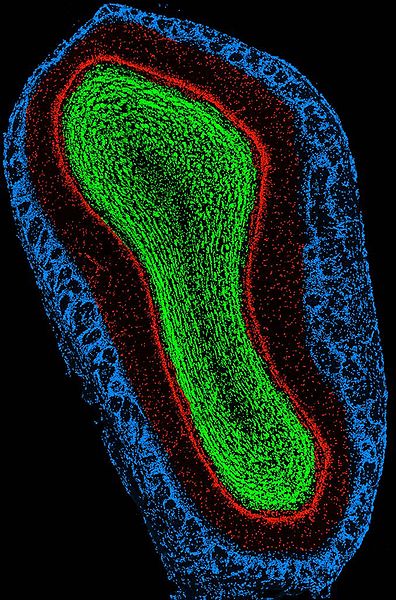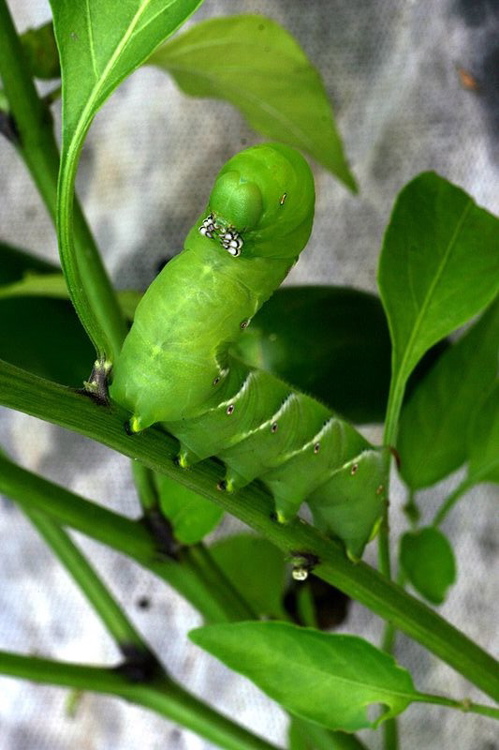Flush Your Lungs Out!
 Monday, November 1, 2010 at 04:03AM
Monday, November 1, 2010 at 04:03AM  A premature infant (26 weeks 6 days) in an incubator.Meconium is basically a baby or foetus’ first stool. Turd that is, not furniture item. Meconium is waste matter made up of amniotic fluid, mucus, water, bile, epithelial cells and lanugo (extremely fine downy hairs that the foetus sheds at about 33 to 36 weeks). Normally meconium stored in the infant's intestines until after birth. It doesn’t have much odour, it’s basically sterile, but it’s thick and sticky and in my opinion it’s pretty gross. It is perhaps even more gross when the meconium is expelled into the amniotic fluid. Sometimes (between 5 and 20 percent of the time) this happens during labour or delivery. The situation turns from unpleasant to dangerous if the baby inhales the meconium. It is not wise to breathe stools (of any kind).
A premature infant (26 weeks 6 days) in an incubator.Meconium is basically a baby or foetus’ first stool. Turd that is, not furniture item. Meconium is waste matter made up of amniotic fluid, mucus, water, bile, epithelial cells and lanugo (extremely fine downy hairs that the foetus sheds at about 33 to 36 weeks). Normally meconium stored in the infant's intestines until after birth. It doesn’t have much odour, it’s basically sterile, but it’s thick and sticky and in my opinion it’s pretty gross. It is perhaps even more gross when the meconium is expelled into the amniotic fluid. Sometimes (between 5 and 20 percent of the time) this happens during labour or delivery. The situation turns from unpleasant to dangerous if the baby inhales the meconium. It is not wise to breathe stools (of any kind).
If a baby has inhaled meconium, doctors will sometimes try to suction it out very shortly after birth. If the baby’s condition remains poor or worsens, he/she will often be placed into a ventilator to be monitored my medical staff and provided with oxygen until his/her lungs recover. This is a pretty good strategy in modern western hospitals. In developing countries, however, this technology is often harder to access and maintain. A team from five countries might have an answer to this challenge and – if we weren’t discussing a baby - it would be entirely intuitive. Dirty lungs? Clean them. Specifically, flush them out with a dilute soapy, detergent-like liquid. It’s known as lavage. The baby is actually disconnected from the ventilator for a minute or so while the lavage fluid is being instilled into the lungs and then suctioned back out.
The idea of flushing out lungs with a soapy solution seems extreme, but it’s not an entirely new concept. There have been studies going back more than ten years examining the effectiveness of the treatment. In their paper (published in The Journal of Pediatrics, 14 October 2010), Dr Peter Dargaville and his colleagues indicate that this technique is effective. In their study, infants who had the lavage treatment were much more likely to survive and far less likely to need ongoing treatment in a ventilator, compared to those who did not receive the lavage.
Dr Dargaville suggests that this treatment could save the lives of thousands of babies worldwide, especially in developing countries. Sightly disturbing, a bit gross, but fascinating and possibly a life saver.
Light, as a Matter Olfact
 Sunday, October 24, 2010 at 01:31AM
Sunday, October 24, 2010 at 01:31AM  I really should know better than to be surprised at the findings - and techniques – of science, but this is pretty cool. The 17 October edition of Nature Neuroscience published a paper detailing experiments in optogenetics. The researchers incorporated light-reactive proteins into the olfactory systems of mice, so that the systems are triggered by light rather than smell.
I really should know better than to be surprised at the findings - and techniques – of science, but this is pretty cool. The 17 October edition of Nature Neuroscience published a paper detailing experiments in optogenetics. The researchers incorporated light-reactive proteins into the olfactory systems of mice, so that the systems are triggered by light rather than smell.
Basically they have genetically engineered the mice so their noses act like retina.
Now, the idea of mice being able to smell light is interesting (although perhaps not as fantastic as mice that can see odours), but of course that’s not the point of the research.
As you might imagine, administering an odour in an experimental setting can be a fairly imprecise act. The main point of this research is to improve the efficiency of neuroscientific experimentation, by replacing odour with light.
With their genetically engineered mice, the researchers (from Cold Spring Harbor Laboratory, the National Centre for Biological Sciences in Bangalore and Harvard University) were able to conduct experiments targeting specific neurons in the nose and observe the neuronal activity that was triggered in the odour scenting section of the brain (the olfactory bulb).
Now, don’t panic, but here’s just a little bit of neuro-morphology which help make the value (and the point) of this research a bit clearer.
 The main olfactory bulb of an adult mouse. Image taken with a confocal microscope. False colour (applied with Photoshop) indicates the three main layers: blue - Glomerular layer; red - External Plexiform and Mitral cell layer; green - Internal Plexiform and granule cell layer. Image: Matt Valley
The main olfactory bulb of an adult mouse. Image taken with a confocal microscope. False colour (applied with Photoshop) indicates the three main layers: blue - Glomerular layer; red - External Plexiform and Mitral cell layer; green - Internal Plexiform and granule cell layer. Image: Matt Valley
When a smell enters the nose, it is detected by the olfactory epithelium (in the nasal cavity). Millions of neurons then transfer this information to the olfactory bulb to be “sorted”. Each of these neurons is specialised to express a single molecular odour receptor type – one of 1500 that a mouse can detect. The axons of these neurons cluster in structures known as glomeruli (singular glomerulus). These form the outer section of the olfactory bulb, known (unsurprisingly) as the glomerular layer (coloured blue in the image on the right). The section coloured green is the plexiform layer (supporting nerve tissue), but it’s the red section that was of most interest to this study. This section is the mitral cell layer. Cells in the mitral layer transfer information - that has first been processed in the glomerular layer - to the olfactory cortex. In the olfactory cortex “decisions” are made as to what the smells “mean” and what to do about them.
This research has already revealed a great deal about the structure and layout of the olfactory systems. For a start, it seems that there are more information channels leaving the olfactory bulb than there information types entering it. It also seems that the timing of neuronal stimulation plays a part in the perception of smell. Each glomerulus gathers information about one specific type of odour, but is connected to about 15,000 mitral cells. Even though the information coming to these cells from the glomeruli come from neurons detecting the same odour molecules at about the same time, it turns out that this information is not simply transferred to the olfactory cortex. The mitral cells fire at different rates and asynchronously. It is early days, but this might provide more detailed or nuanced information to the olfactory cortex.
Apart from developing a system that uses light to trigger a response in cells that are designed to detect smells (which I still think is really cool) the techniques used in the research have great potential to help elucidate the complex processes the underpin neural “wiring” and the processes of the brain in general. Dare I say it – this could be a sniff of things to come.
The paper by Ashesh K. Dhawale, Akari Hagiwara, Upinder S. Bhalla, Venkatesh Murthy and Dinu F. Albeanu can be found at http://www.nature.com/neuro/index.html
Red-shifting bacteria
 Sunday, August 29, 2010 at 05:22AM
Sunday, August 29, 2010 at 05:22AM  Stromatolites at Shark Bay, Western Australia. Image by C Eeckhout (Wikimedia Commons)Photosynthesis is great. Plants (and some bacteria) use some CO2, some H2O, and a bit of sunlight to build themselves. The sunlight involved is mainly within the visible range of the electromagnetic spectrum, especially around 430 nanometres (violet) and 660 nanometres (red).
Stromatolites at Shark Bay, Western Australia. Image by C Eeckhout (Wikimedia Commons)Photosynthesis is great. Plants (and some bacteria) use some CO2, some H2O, and a bit of sunlight to build themselves. The sunlight involved is mainly within the visible range of the electromagnetic spectrum, especially around 430 nanometres (violet) and 660 nanometres (red).
When I say “some bacteria”, I refer to cyanobacteria. These fabulous organisms are believed to have triggered a huge boost in early biodiversity when they started photosynthesising (about 3.5 billion years ago), absorbing CO2 and releasing O2. It looks like these guys have been keeping a pretty special secret.
Some of those early cyanobacteria are still around today. In a few choice locations around the world (for example Shark Bay in Western Australia) you can see living stromatolites, rock-like structures built up by microorganisms – especially cyanobacteria. If you do drop by for a visit, you might wonder how light reaches the cyanobacteria deep inside the stromatolite. Certainly light in the visible region of the electromagnetic spectrum would not penetrate that far. Well the compound that actually absorbs the light is chorophyll and a team from the Universities of Sydney, New South Wales, Munich as well as Macquarie University have discovered a brand new – but very old - form of chrorphyll. Dubbed “chlorophyll f”, this new chlorophyll was discovered in cyanobacteria inside stromatolites and can absorb light wavelengths more than 700 nanometres (in the near-infrared region of the electromagnetic spectrum).
This discovery might have implications for future energy generation technologies, and even the odds of life on other planets, but perhaps more importantly it is a reminder that we stil have a lot to learn about the world around us – even the really old bits.
Tobacco is bad for you
 Sunday, August 29, 2010 at 02:16AM
Sunday, August 29, 2010 at 02:16AM  My university botany lecturers at uni would probably be surprised to hear that any of their teaching had stuck in my mind, but some did. One enduring impression is that plants are very complex organisms and that humans probably don’t recognise the diversity of and precision of their survival mechanisms. Here’s some more evidence.
My university botany lecturers at uni would probably be surprised to hear that any of their teaching had stuck in my mind, but some did. One enduring impression is that plants are very complex organisms and that humans probably don’t recognise the diversity of and precision of their survival mechanisms. Here’s some more evidence.
Smoking tobacco is not good for you. Chewing tobacco is also unwise, especially if you are a tobacco hornworm caterpillar. A quick nibble on a tasty tobacco leaf will trigger an emergency response from the tobacco plant that calls in some serious reinforcements.
When damaged, the tobacco plant releases green leaf volatiles (GLVs). These are the compounds that give freshly mowed grass its distinctive aroma. Up to now it was thought that the GLVs send out a signal chemical signal that attracts predators. The predators then eat the herbivores that are consuming the plant.
It turns out that when the tobacco species Nicotiana attenuata is attacked by tobacco hornsworms (the caterpillar of stage of Manduca sexta), the chemical signal produced is different to the signal released if the tobacco plant is damaged in some other way.
Ian Balwin of the Max Planck Institute for Chemical Ecology, Germany, and Silke Allman of the Department of Plant Physiology, Swammerdam Institute for Life Sciences, Netherlands, found that when the saliva of the hornworm caterpillar mixes with the GLVs released by the plant, they are changed maiking them even more effective at attracting predators. Frankly, don’t mess with tobacco plants – they have friends in low places.
Free will eh?
 Monday, July 26, 2010 at 05:47AM
Monday, July 26, 2010 at 05:47AM  Yesterday I went to see Inception and it was great. Time will tell whether it’s “an instant classic” as David Stratton suggested, but it was certainly lots of fun. Like many people, I am intrigued by the unconscious (and subconscious) mind, so if you’re one of those people, I recommend it. Fascination with the sleeping mind is what eventually led me to write Somnium.
Yesterday I went to see Inception and it was great. Time will tell whether it’s “an instant classic” as David Stratton suggested, but it was certainly lots of fun. Like many people, I am intrigued by the unconscious (and subconscious) mind, so if you’re one of those people, I recommend it. Fascination with the sleeping mind is what eventually led me to write Somnium.
In any case, Inception reminded me about a recent article in Science (2 July 2010), suggesting that the unconscious mind might control our actions more than we give it credit for. Ruud Custers and Henk Aarts of Utrecht University reviewed research examining the role of the unconscious mind in decision making and it makes for interesting reading. I don’t know whether Leonardo DiCaprio is actually affecting your thoughts, but if he wants to, your brain might have all the right software in place.
According to Custers and Aarts the human brain is designed for constant action, continuously gathering and processing information both consciously and unconsciously. The authors describe the steps involved in pursuing a goal. These steps are taking a positive goal or task in mind (“considering” the goal), determining how easily the goal can be achieved (is it even possible) and assessing value of the goal (what’s in it for me). Much of this happens without conscious effort.
For example, students asked to complete word puzzles featuring positive words like “win” or “achieve” will outperform students attempting puzzles with more neutral words. These are types of cues or influences are known as “primes” and in this case they are consciously recognisable. Subliminal primes, however, have also been shown to lead to goal pursuit and achievement.
Students asked to squeeze a hand grip in response to a start signal, will squeeze earlier if they have been presented with subliminal messages suggesting physical exertion. They would also squeeze harder and for longer if their subliminal messaging included words suggesting reward (such as “good or “nice”).
Custers and Aarts also cite MRI studies showing that many processes of goal pursuit happen in the limbic system of the brain. This is a fascinating region that - among many other things - is believed to influence hunger, thirst, blood pressure, circadian rhythms, sexual arousal, our sense of smell and balancing fear and reward.
I remember reading (somewhere) that toddlers do some of their learning by trying to achieve outcomes, rather than trying to mimic processes, a subtle but important distinction.
None of this means that your conscious thoughts don’t matter, but don’t underestimate what your brain does without you knowing.
